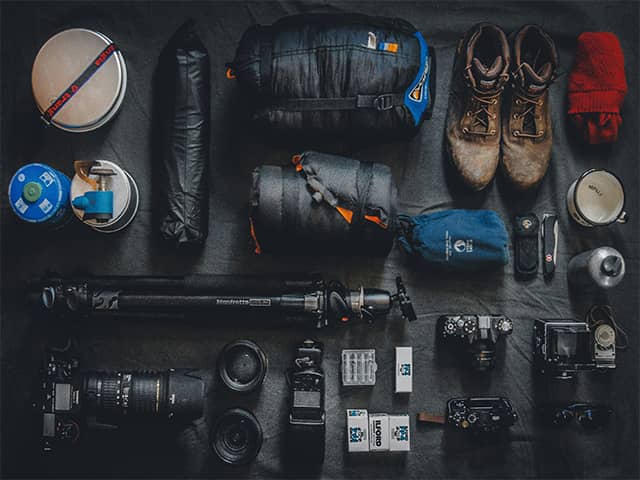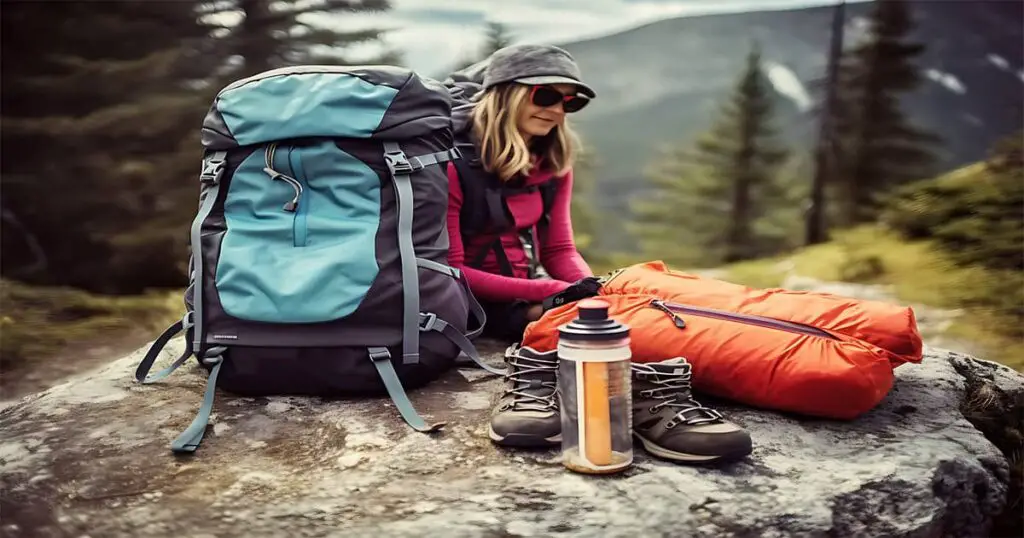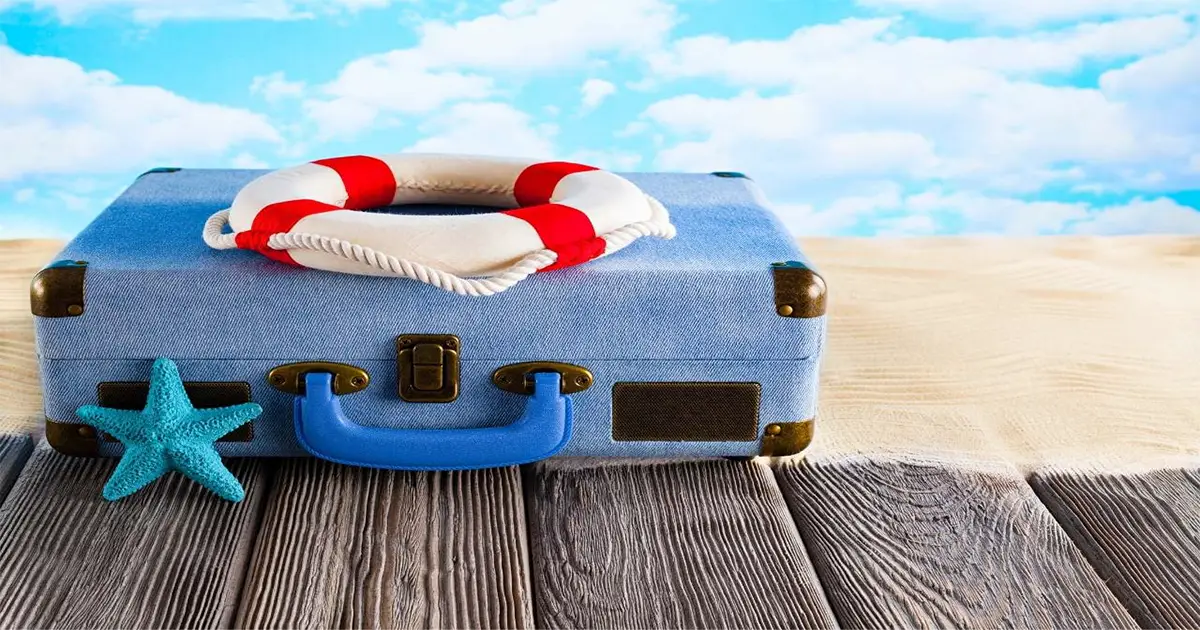Efficient Camping Gear Transport Tips & Tricks

Are you planning a camping trip and wondering about the best way to transport your camping gear? Look no further! In this article, I will share some efficient tips and tricks to help you pack and organize your camp gear for a hassle-free outdoor experience.
Whether you’re heading out on a camping adventure with your family or embarking on a solo escapade, it’s important to pack your camping equipment properly to ensure a smooth journey. From packing smart and utilizing storage space to considering weight distribution, I’ll cover it all.
Key Takeaways:
- Plan and make a checklist of all the camping gear you will need.
- Pack efficiently and utilize storage space effectively.
- Consider the weight and distribution of your camping gear for safe transportation.
- Maximize space in your vehicle by using the back of the car and roof rack.
- Be aware of airline restrictions if flying to your camping destination.
Plan and Make a Checklist
Before you start packing for your camping trip, it’s important to plan ahead and create a checklist of all the camping supplies you’ll need. Taking the time to make a detailed list will ensure that you don’t forget any essential items and make the most of your camping experience.
Firstly, consider the size of your camper or car camping space. Understanding the limitations of your storage area will help you prioritize which camping gear to bring along. Remember to leave enough room for other essentials, such as food and clothing.
Once you have an idea of the available space, start making your checklist. Begin with the basics, like a tent, sleeping bags, and cooking equipment. Don’t forget to include important camping supplies such as flashlights, insect repellent, and a first aid kit.
When making your camping checklist, think about the specific needs of your trip. Are you planning on hiking? Add hiking boots, backpacks, and a map to your list. Is there a chance of rain? Bring waterproof clothing and tarps to stay dry. By tailoring your checklist to your individual camping plans, you’ll have everything you need for a comfortable and enjoyable adventure.
A well-organized camping checklist will not only ensure you have all the necessary items, but it will also serve as a guide for packing and setting up your campsite. It’s also useful for future camping trips, as you can review and update your checklist based on your experiences.
“A checklist is essential for any successful camping trip. It helps you stay organized and ensures you don’t forget any crucial camping supplies.” – Outdoor Enthusiast
Packing Checklist:
Here’s a comprehensive packing checklist to help you get started:
| Camping Gear | Kitchen | Sleeping | Personal | Miscellaneous |
|---|---|---|---|---|
|
|
|
|
|
Feel free to customize this checklist to suit your specific camping needs. Remember to check off each item as you pack it to ensure nothing gets left behind.
With a well-planned and organized camping checklist, you can rest easy knowing that you have everything you need for a successful camping trip. Happy camping!
Pack Smart and Utilize Storage Space
When preparing for a camping trip, it’s crucial to be smart about how you pack and utilize storage space. By following a few simple tips, you can ensure that your camping gear is well-organized, easily accessible, and efficiently transported.
Unpack and Organize Your Tent
Begin by unpacking your tent and organizing it in a compact manner. This will not only save space but also make it easier to transport. Make sure to neatly fold the tent and pack it in a way that minimizes its size.
Use Plastic Storage Containers
To keep your camping supplies, camp kitchen utensils, toiletries, and dry food organized, consider using plastic storage containers. These containers are lightweight, durable, and provide ample space for all your essentials. Label the containers to quickly identify their contents, making it easier to locate items when needed.
Maximize Storage Space
When packing, it’s important to maximize storage space. Place smaller items inside larger ones whenever possible to utilize available space efficiently. For example, you can store toiletries inside cooking pots or keep dry food in airtight containers to save space and keep your items fresh.
Additionally, utilize any nooks and crannies in your vehicle or backpack for extra storage. This could include using the space under or behind seats, or in the trunk/boot area of your vehicle. Every bit of space counts when transporting camping gear.
Consider Additional Storage Solutions
If you find yourself needing extra storage space, there are several additional solutions you can explore. Hanging organizers can be attached to the inside of your tent to store smaller items. Mesh pockets can be hung from trees or poles to keep frequently used items easily accessible.
Furthermore, collapsible storage bags or cubes can be used to compress items and save space. These are ideal for bulky items such as clothing, sleeping bags, or inflatable mattresses.
“Efficient packing and utilization of storage space can make a significant difference in the ease and convenience of your camping trip.”
Consider Weight and Distribution
When it comes to loading your camping gear for transportation, considering the weight and distribution is crucial for a safe and comfortable journey. *Sleeping bag*, *backpack*, *stove*, and *utensils* are some of the heavier items that should be placed at the bottom of your cargo to create a stable base. This way, you can prevent any shifting or sliding during transit and ensure the overall balance of your load.
If you’re bringing large equipment like a *kayak*, it’s essential to secure it properly using a cargo carrier or hitch. This helps ensure that it remains stable and tightly fastened throughout your journey.
Additionally, grouping items together is a smart strategy to evenly distribute the weight and optimize space. For example, keep your *camping and hiking gear* together and store your *cooking equipment* in a separate container. By doing so, you’ll not only make the most of your available space but also maintain a well-balanced load.
| Items | Grouping |
|---|---|
| Sleeping bag, backpack, stove, utensils | Heavier items at the bottom |
| Kayak, large gear | Secure using a cargo carrier or hitch |
| Camping and hiking gear | Group together |
| Cooking equipment | Store separately |
By carefully considering the weight and distribution of your camping gear, you’ll ensure a safer and more enjoyable journey to your campsite.
Maximize Space in Your Vehicle
To make the most of your vehicle’s storage space during your camping trip, there are a few tips and tricks you can follow. Utilizing the back of the car efficiently is key. Consider using the roof rack to store items that can withstand outside conditions, such as camp chairs or a tarp. This will free up space inside the vehicle for other essential gear.
When it comes to organizing smaller items, storage bins or shelves can be a lifesaver. These help keep everything in its place, preventing damage during transportation. You can categorize your gear and store them in separate bins for easy access and inventory control.
Don’t forget about the spare tire area or boot space! These areas are often overlooked and can provide valuable extra storage space. Utilize them to store essential camping gear that you may not need immediate access to.
It is important to avoid damaging your vehicle while transporting camping gear. Be mindful of the weight distribution to ensure a smooth ride. Pack heavier items towards the bottom to create a stable base and avoid shifting during travel. Additionally, consider using protective coverings or padding for fragile items to minimize the risk of damage.
With these tips, you can maximize the available space in your vehicle and ensure a stress-free camping trip.
Consider Airline Restrictions for Flying
If you’re planning your next camping adventure and need to bring your camping supplies with you, it’s important to consider airline restrictions when flying. Different airlines have different guidelines for checked baggage, so it’s essential to check their policies before you start packing. This way, you’ll know what camping gear you can and cannot bring on your flight.
One way to avoid worrying about checked baggage weight limits is to consider using a duffel bag for your camping equipment. Duffel bags are versatile and can conform to different spaces, making them easier to fit into the aircraft’s overhead bins or the cargo hold. With a duffel bag, you can maximize the space available to you without having to worry too much about weight restrictions.
However, it’s important to note that certain camping gear, such as sharp items or flammable materials, may be restricted by the Transportation Security Administration (TSA) for safety reasons. To avoid any issues at the security checkpoint, it’s recommended to pack these items in your checked bag rather than your carry-on. This way, you can still bring your essential camping gear without any problems.
Pack Light and Compact for Backpacking
When preparing for a backpacking adventure, it’s essential to pack light and compact. As an outdoor enthusiast, I understand the importance of carrying everything you need while ensuring comfort and safety. Here are some tips to help you pack efficiently:
-
- Opt for smaller items:
Choose gear and equipment that are lightweight and compact. Invest in smaller versions of camping essentials, such as a lightweight sleeping bag and a compact camping stove.
-
- Utilize plastic bins or compression bags:
Maximize the limited space in your backpack by using plastic bins or compression bags. These storage solutions can help you organize your gear and optimize space.
-
- Plan your meals:
Consider planning your meals in advance to avoid carrying excess food. Opt for dehydrated meals or lightweight dry food that will take up less space and reduce weight.
-
- Choose multipurpose items:
When selecting your gear, look for items that serve multiple functions. For example, a multi-tool can be used for various tasks, eliminating the need to carry individual tools.
-
- Think carefully about clothing:
Pack only the essential clothing items you’ll need for the duration of your backpacking trip. Choose lightweight and quick-drying fabrics that can easily be layered.
-
- Consider your destination:
Take into account the specific requirements of your backpacking destination. Research the weather conditions and terrain to ensure you pack the right gear for the environment.
By following these packing tips, you can enjoy a lightweight and comfortable backpacking experience without compromising on the necessary equipment and supplies.
Quote:
“Travel light, live light, spread the light, be the light.” – Yogi Bhajan
| Advantages of Packing Light and Compact for Backpacking: |
|---|
| 1. Enhanced mobility and flexibility during hikes |
| 2. Reduced strain on your body |
| 3. Easy access to your gear when needed |
| 4. Faster and more efficient movement through challenging terrains |
| 5. Increased enjoyment of the backpacking experience |
Secure Loose Items
Before hitting the road, it’s crucial to ensure that there are no loose items in your camping gear. To prevent these items from moving around during transportation, it’s important to secure them properly. Here are some tips to help you keep your camping gear organized and secure:
Reusable Bags and Larger Bags
One effective way to prevent loose items from shifting during transportation is to use reusable bags. These bags are not only eco-friendly but also provide a secure way to store and transport your gear. Place smaller loose items in these bags and seal them tightly. For larger items that don’t fit in reusable bags, consider using a larger bag with secure closures. This will ensure that nothing gets lost or damaged during the journey.
Plastic Bins with Lids
For smaller items that need extra protection, such as camping accessories or personal belongings, plastic bins with lids are ideal. These bins will not only keep your items secure but also prevent them from getting mixed up or lost in transit. The sturdy lids will ensure that everything stays in place, even if the bins accidentally jostle during the journey.
Shelves for Organization
If you’re looking for a more organized approach to securing your loose items, consider using shelves. Shelves provide a stable surface to store your items and prevent them from shifting or falling over. Place the shelves strategically inside your vehicle to create compartments for different categories of gear. This will help you easily locate your items when you need them and keep everything in order throughout your trip.
Double-Check for Safety
Before you hit the road, double-check to ensure that there is nothing loose in your camping gear. Take a few moments to walk around your vehicle and inspect all your bags, bins, and shelves. Confirm that each item is securely fastened or stored, and make any necessary adjustments to avoid any potential accidents or damage on the road.
By taking the time to secure your loose items using reusable bags, larger bags, plastic bins with lids, and shelves, you can have peace of mind knowing that your camping gear is safely stored and transported. This will allow you to fully enjoy your outdoor adventure without worrying about misplaced or damaged items.
Pack Essential Safety Items
When it comes to camping, safety should always be a top priority. Being prepared for any unexpected situations will give you peace of mind and allow you to enjoy your camping trip to the fullest. Here are some essential safety items that you should pack:
First Aid Kit
Having a well-stocked first aid kit is crucial for any camping adventure. Make sure your kit includes band-aids, gauze, adhesive tape, disinfectant, pain relievers, tweezers, and any necessary medications. It’s always better to be prepared for minor injuries or health concerns.
Bear Spray
If you’re camping in an area known for bears, carrying bear spray is essential for your safety. Bear spray is a non-lethal deterrent that can be used to protect yourself in case of a bear encounter. Familiarize yourself with how to use it correctly and keep it easily accessible.
Bug Spray
Don’t let pesky bugs ruin your camping experience. Pack bug spray to protect yourself from mosquito bites and other insects. Look for a repellent that contains DEET or other recommended ingredients to effectively ward off bugs and ticks.
Duct Tape
Duct tape is a versatile item that can come in handy in various situations. It can be used for quick repairs, securing items together, or creating makeshift solutions. Pack a roll of duct tape in your camping gear to be prepared for any unexpected situations that may arise.
Relevant Repellents
In addition to bug spray, consider packing repellents specific to the area you’ll be camping in. This could include mosquito coils, citronella candles, or electronic repellent devices. Research the local pests and choose the appropriate repellents to ensure a comfortable camping experience.
Aerosol Safety
When packing aerosol products such as bug spray or repellents, be mindful of how you store and transport them. Ensure they are tightly sealed and avoid placing them near direct heat or flames to prevent accidents. Follow the manufacturer’s instructions and guidelines for safe usage.
By including these essential safety items in your camping gear, you’ll be well-prepared for any situation that may arise. Remember, it’s better to be safe than sorry! Stay prepared, stay safe, and have a wonderful camping trip.
| Safety Item | Description |
|---|---|
| First Aid Kit | A well-stocked kit containing essentials like band-aids, disinfectant, pain relievers, etc. |
| Bear Spray | A non-lethal deterrent to protect yourself in case of a bear encounter. |
| Bug Spray | Repellent to keep mosquitoes and other insects at bay. |
| Duct Tape | Versatile item for quick repairs and securing items together. |
| Relevant Repellents | Additional repellents specific to the area you’ll be camping in. |
| Aerosol Safety | Safe storage and transport of aerosol products to prevent accidents. |
Consider Affiliate Links for Purchases
If you’re considering purchasing new camping gear, I highly recommend making use of affiliate links when available. By doing so, you not only get the items you need for your camping trip but also support the content creator or website that provided you with the gear recommendations. It’s a win-win situation!
When you make a purchase through affiliate links, a small commission is generated for the content creator or website. This helps them continue producing valuable and informative content for outdoor enthusiasts like yourself. Plus, it doesn’t cost you anything extra! So why not show your support?
By choosing affiliate links, you can ensure that the camping gear you choose is of high quality and meets your specific needs. Content creators often provide honest and unbiased reviews, making it easier for you to make an informed decision. Whether it’s a new tent, hiking gear, or cooking equipment, these affiliate links can lead you to the perfect items for a successful camping trip.
So, the next time you’re browsing through gear recommendations or product reviews, keep an eye out for affiliate links. By clicking on these links and making a purchase, you’ll not only get the camping gear you need but also help support the content creators who tirelessly work to provide you with valuable insights and recommendations.
Remember, every purchase counts and makes a difference. So let’s support the outdoor community by using affiliate links when available. Happy camping and happy shopping!
Conclusion
In conclusion, transporting your camping gear efficiently is essential for a hassle-free outdoor adventure. By planning, organizing, and packing smart, you can ensure that everything you need is safely transported and easily accessible at your campsite.
Remember to consider the specific requirements of your camping trip, whether you’re car camping or backpacking, and always prioritize safety. Pack essential items such as a first aid kit, bear spray, and bug spray to ensure you’re prepared for any situation.
With proper planning, you can maximize space in your vehicle, distribute weight evenly, and secure loose items to prevent damage during transportation. Whether you’re a camping enthusiast or a beginner, following these tips will help you enjoy a successful and memorable camping trip. Happy camping!
Read to know What To Pack For An Amusement Park? 15 Essentials For You
FAQ
What items should I include on my camping checklist?
When making your camping checklist, include essential items such as a tent, camp kitchen supplies, toiletries, dry food, sleeping bags, backpacks, cooking equipment, and camping and hiking gear.
How can I pack my camping gear efficiently?
To pack your camping gear efficiently, start by unpacking your tent and organizing it in a compact manner. Utilize plastic storage containers for your camping supplies, camp kitchen utensils, toiletries, and dry food. This will save space and keep your items organized and easily accessible.
What should I consider when distributing the weight of my camping gear?
When loading your camping gear, place heavier items like sleeping bags, backpacks, stoves, and utensils at the bottom to create a stable base. Group items together, such as cooking equipment and camping and hiking gear, to ensure even weight distribution.
How can I maximize space in my vehicle for camping gear?
Utilize the back of the car efficiently by using a roof rack to store items that can withstand outside conditions, such as camp chairs or a tarp. Consider using storage bins or shelves to keep smaller items organized and prevent damage during transportation. Make use of the spare tire area or boot space to store essential camping gear.
What should I consider when flying with camping gear?
If you’re flying to your camping destination, check the airline’s guidelines for checked baggage. Consider using a duffel bag as it can conform to different spaces and may be easier to organize. Pack any camping gear that might be restricted by the TSA in your checked bag to avoid any issues at the security checkpoint.
How can I pack efficiently for backpacking?
When backpacking, pack light and compact. Opt for smaller items and use plastic bins or compression bags to maximize space in your backpack. Carry everything you need as an outdoor enthusiast without compromising comfort or safety.
How can I secure loose items in my camping gear?
Before hitting the road, secure loose items properly using reusable bags or keep them in a larger bag to prevent them from moving around during transportation. Use plastic bins with lids or shelves for smaller items to ensure everything stays in place.
What safety items should I pack for camping?
Pack essential safety items such as a well-stocked first aid kit, bear spray, bug spray, duct tape, and appropriate repellents. These items will ensure you’re prepared for any unexpected situations and can enjoy your camping trip with peace of mind.
Should I consider using affiliate links for camping gear purchases?
If you’re considering purchasing new camping gear, make use of affiliate links when available. By making a purchase through affiliate links, you can support the content creator or website you found the gear recommendations from and ensure high-quality gear for your camping trip.




